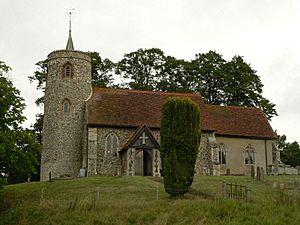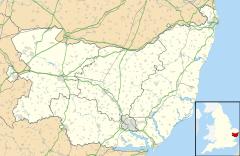Aldham facts for kids
Quick facts for kids Aldham |
|
|---|---|
 Aldham St Mary church |
|
| Population | 175 (2011) |
| OS grid reference | TM0445 |
| District | |
| Shire county | |
| Region | |
| Country | England |
| Sovereign state | United Kingdom |
| Post town | Ipswich |
| Postcode district | IP7 |
| Police | Suffolk |
| Fire | Suffolk |
| Ambulance | East of England |
| EU Parliament | East of England |
Aldham is a small village in Suffolk, England. It's located about 8 miles (13 km) west of Ipswich. Aldham is also a "civil parish," which is a local area with its own council, like a small local government. In 2011, about 175 people lived there.
Contents
History of Aldham
The name Aldham comes from old English words. It likely means "Ealda's meadow" or "old meadow." This tells us the village has been around for a very long time.
Aldham in the Domesday Book
Aldham was mentioned in the Domesday Book. This was a famous survey of England completed in 1086 by order of King William the Conqueror. At that time, Aldham had a population of just 16 people.
Aldham St Mary Church
The church of Aldham St Mary is special. It is one of only 38 churches in Suffolk that have a unique round tower. You might have even seen it on TV! The church appeared in the second series of the BBC Four show Detectorists.
Rowland Taylor's Memorial
In 1555, a sad event happened at Aldham Common. Dr Rowland Taylor, who was a church leader from Hadleigh, was killed there. He was a Protestant and died for his beliefs during a time when Protestants faced harsh treatment in England. This period is known as the Marian Persecutions.
Today, you can find two monuments marking the spot where he died. One is a rough, unshaped stone that was probably placed there in the early 1600s. The other is a pyramid-shaped stone monument. It was put up in 1818 and later fixed up by local people in 1882. This monument is considered a Grade II listed building, which means it's an important historical structure.
Population of Aldham
The number of people living in Aldham has changed over time. In 2001, about 200 people lived in the village. By 2011, the population had gone down slightly to 175 people. These numbers come from the official Office for National Statistics in the United Kingdom.


